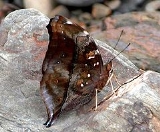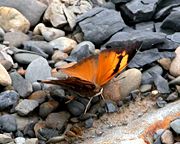
Doleschallia bisaltide
Encyclopedia
The Autumnleaf Doleschallia bisaltide is a nymphalid
butterfly found in India
, also found in Australia where known as Leafwing.
 Race malabarica, Fruhstorfer.— Males and females underside yellowish brown, paling anteriorly to rich golden yellow on the fore wing, shading anteriorly into dusky brown on the hind wing. Forewing: the apical half black, following a line from vein 12 opposite the Discocellulars, passing through apex of cell, obliquely across middle of interspace 3 and curving down to tornus ; a black spot near apex of cell coalescing with the inner margin of 1he black colour; a short, very oblique, broad golden-yellow band, broader in the female than in the male, from middle of costal margin to interspace 5; a spot beyond in line with it in interspace 4; two, sometimes three, minute, preapical white specks; the cilia fulvous, touched with white, anteriorly. Hind wing uniform ; the costal margin broadly as noted above, a subterminal narrow band and narrower terminal line posteriorly, dusky black; a postdiscal black spot in interspaces 2 and 5 respectively; the cilia fulvous. Underside very variable, closely resembling a dry leaf. No two specimens are ever alike. The ground-colour varies from reddish to dark greenish brown with irrorations of greyish and black scales; apex of the fore and the terminal margin posteriorly of the hind wing more or less lilacine; fore and hind wings crossed by a dark narrow discal fascia, generally bordered on the inner side by a greyish line; this fascia bent inwards at right angles above vein 6 of the forewing and in most specimens, bordered internally by a diffuse pale patch and externally by an oblique whitish mark, beyond which is a subcostal white spot, followed by a transverse sinuous postdiscal series of obscure ocelli crossing both wings, each ocellus centred by a minute dot, white on the fore, black on the hind wing. In the male there are generally, but not invariably, a number of whitish spots on the basal areas of both wings.
Race malabarica, Fruhstorfer.— Males and females underside yellowish brown, paling anteriorly to rich golden yellow on the fore wing, shading anteriorly into dusky brown on the hind wing. Forewing: the apical half black, following a line from vein 12 opposite the Discocellulars, passing through apex of cell, obliquely across middle of interspace 3 and curving down to tornus ; a black spot near apex of cell coalescing with the inner margin of 1he black colour; a short, very oblique, broad golden-yellow band, broader in the female than in the male, from middle of costal margin to interspace 5; a spot beyond in line with it in interspace 4; two, sometimes three, minute, preapical white specks; the cilia fulvous, touched with white, anteriorly. Hind wing uniform ; the costal margin broadly as noted above, a subterminal narrow band and narrower terminal line posteriorly, dusky black; a postdiscal black spot in interspaces 2 and 5 respectively; the cilia fulvous. Underside very variable, closely resembling a dry leaf. No two specimens are ever alike. The ground-colour varies from reddish to dark greenish brown with irrorations of greyish and black scales; apex of the fore and the terminal margin posteriorly of the hind wing more or less lilacine; fore and hind wings crossed by a dark narrow discal fascia, generally bordered on the inner side by a greyish line; this fascia bent inwards at right angles above vein 6 of the forewing and in most specimens, bordered internally by a diffuse pale patch and externally by an oblique whitish mark, beyond which is a subcostal white spot, followed by a transverse sinuous postdiscal series of obscure ocelli crossing both wings, each ocellus centred by a minute dot, white on the fore, black on the hind wing. In the male there are generally, but not invariably, a number of whitish spots on the basal areas of both wings.
Antennae blackish brown, ochraceous at apex ; head, thorax and abdomen dark fulvous brown; beneath, the palpi white, the thorax and abdomen pale brown.
Expanse 84–88 mm
Sikkim, S. India, Ceylon, Assam, Myanmar and Tenasserim.
Race andamanensis or andamana, Fruhstorfer (The Andamans), closely resembles the Indian form, but differs in the oblique yellow band on the upperside of the fore wing, which is broader and extends from the middle of the costal margin uninterruptedly to interspace 4, though it is preapically constricted. On the upperside of the hind wing there is an inner as well as an outer conspicuous subterminal narrow-black band. On the underside this race is as variable as the typical form, but the ground-colour in many specimens (presumably wet-season broods) is of a richer, almost metallic green, with the basal snow-white spots defined with black lines ; the ocelli in interspaces 2 and 5 seem also to be more clearly defined than in the Indian form. Antennae, head, thorax and abdomen as in malabarica.
This race has been seen in the S. Andaman (Chidiyatapu), Car Nicobar, Central Nicobars and at Great Nicobar. They are attracted to the flowers of Ligustrum glomeratum and larvae have been discovered on Pseuderanthemum album (Acanthaceae).
Nymphalidae
The Nymphalidae is a family of about 5,000 species of butterflies which are distributed throughout most of the world. These are usually medium sized to large butterflies. Most species have a reduced pair of forelegs and many hold their colourful wings flat when resting. They are also called...
butterfly found in India
India
India , officially the Republic of India , is a country in South Asia. It is the seventh-largest country by geographical area, the second-most populous country with over 1.2 billion people, and the most populous democracy in the world...
, also found in Australia where known as Leafwing.
Description

Antennae blackish brown, ochraceous at apex ; head, thorax and abdomen dark fulvous brown; beneath, the palpi white, the thorax and abdomen pale brown.
Expanse 84–88 mm
Sikkim, S. India, Ceylon, Assam, Myanmar and Tenasserim.
Race andamanensis or andamana, Fruhstorfer (The Andamans), closely resembles the Indian form, but differs in the oblique yellow band on the upperside of the fore wing, which is broader and extends from the middle of the costal margin uninterruptedly to interspace 4, though it is preapically constricted. On the upperside of the hind wing there is an inner as well as an outer conspicuous subterminal narrow-black band. On the underside this race is as variable as the typical form, but the ground-colour in many specimens (presumably wet-season broods) is of a richer, almost metallic green, with the basal snow-white spots defined with black lines ; the ocelli in interspaces 2 and 5 seem also to be more clearly defined than in the Indian form. Antennae, head, thorax and abdomen as in malabarica.
This race has been seen in the S. Andaman (Chidiyatapu), Car Nicobar, Central Nicobars and at Great Nicobar. They are attracted to the flowers of Ligustrum glomeratum and larvae have been discovered on Pseuderanthemum album (Acanthaceae).

